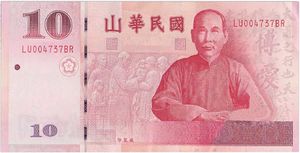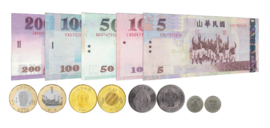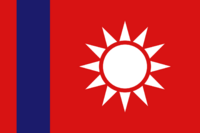Monsilvan yupian
| Yupian | |
|---|---|
 | |
| ISO 4217 | |
| Code | MSY |
| Number | 901 |
| Denominations | |
| Subunit | |
| 1⁄100 | Tzu (ᴛ or 子) |
| Symbol | ¥, 玉, M¥ |
| Banknotes | |
| Freq. used |
|
| Coins | |
| Freq. used |
|
| Demographics | |
| Date of introduction | 12 September 1830 |
| User(s) | |
| Issuance | |
| Central bank | Bank of Monsilva |
| Mint | Monsilvan Mint |
The Monsilvan yupian (abbreviation: ypn; ISO code: MSY) is the official currency of Monsilva. The yupian (sign: ¥ or 玉) is also the main unit and its denominations are known as tzu (ᴛ or 子). There are 100 tzu in 1 yupian.
The yupian is has been circulating in Monsilva since 1830 after the Monsilvan Civil War, and has had many different appearences during the period from then until the present. The yupian banknotes from 1830 until 1978 presented the monarch of Monsilva on the face and a monument on the back. After the mass protests in 1978, the yupian was updated again.
The Bank of Monsilva is the central bank for the yupian. All legal yupian banknotes are regulated by the Bank of Monsilva. The yupian is only valid in Monsilva and some border services in Baltanla (the Baltanese Dong is used similarly on the Monsilvan side). There are currently 5 circulating Yupian banknotes; ¥5, ¥10, ¥50, ¥100 and ¥200; and 4 circulating coins; ¥1, 50ᴛ, 25ᴛ and 10ᴛ. All of these are frequently used as the old ¥500 note which was not used frequently was removed in 2001.
1 Quebecshirite credit (₵) = 6.03 Monsilvan yupian (¥).
Etymology
The word "Yupian" comes from the Monsilvan 玉片 (Yù piàn) meaning 'jade pieces'. Jade is a very valuable material within Monsilvan culture, it has been used in making many sacred ornaments and buildings across Monsilva. However it was stone coins that were commonly used to trade goods, jade was used quite rarely due to its expense. But the stone that was used in the coins was from Yushan Mountain. Yùshān literally means 'jade' (Yù) 'mountain' (shān). These coins were used as a sort of 'currency' for a long period of Monsilvan history and are the original reason why the yupian has its name. In the late 16th century, the emperor of the Kingdom of Great Shan had silver coins minted in order to form a more formal currency for the country. These silver coins which had the emperor's head on the front were used in Monsilva all the way up until 1830, when the Monsilvan yupian was introduced by Chai Lin's government.
Symbol
The currency sign for the Monsilvan yupian is any of three: ¥, 玉 or M¥. The ¥ symbol is commonly used both within Monsilva and internationally, however occasionally in official situations, M¥ is used instead. "玉" is an official character for the yupian in Monsilvan, but is generally only used when written in sentences (eg. "I have ¥500" would be "我有五百玉"), while standalone prices will use the ¥ symbol (eg. a price label would just write "¥500" instead of "五百玉"). The character "玉" (Yù) is Monsilvan for 'jade'. The symbol has very little use outside Monsilva.
Currency code
The ISO 4217 currency code for sterling is "MSY", formed from the ISO 3166-1 code for Monsilva, "MS", and the first letter of "yupian". Banking and finance often use the abbreviation ypn or the pseudo-ISO code YPN.
Subdivisions
The yupian is divided into one hundred tzu (ᴛ or 子). The name "tzu" was used for the silver coins distributed by the Kingdom of Great Shan, these were abolished in 1830.
There are 3 coins that represent a number of tzu smaller than one yupian, these are: 50ᴛ, 25ᴛ and 10ᴛ.
Cash
Physically, the yupian is represented by coins and notes, with divisions above ¥1 being notes, and the smaller divisions and subdivisions being coins.
Notes
The first yupian notes were issued by the Bank of Monsilva shortly after its foundation in 1830. The first denominations of the yupian notes were ¥1, ¥5, ¥10, ¥50, ¥100, ¥200 and ¥500. These notes all remained in circulation (with their looks changing multiple times) until 2001, when the ¥500 note was removed from circulation and made invalid in 2002.
In 1978, Xu Zhou-da replaced the notes with the Monsilvan flag on the face, but each note had a different animal on the back. The ¥1 note had one of Monsilva's national animals, the pheasant; the ¥5 had a herd of deer; the ¥10 had another of Monsilva's national animals, the mountain cat; the ¥50 had a goat; the ¥100 had a peacock; the ¥200 had a school of fish; and the ¥500 had a pod of dolphins. In 1990, the ¥1 note was removed and replaced with a coin.
In 2001, when the ¥500 notes were removed from circulation, the notes designs were changed again. The Monsilvan flag was replaced with different things depending on the note. The backs were changed as well. Currently the notes feature:
- The ¥5 has a group of children celebrating a goal in football on the face and a herd of deer on the back.
- The ¥10 has Chai Lin on the face and Shan-Zhong building on the back.
- The ¥50 has Xu Zhou-da on the face and the Presidential Office on the back.
- The ¥100 has a group of students on the face and two pheasants in front of Mount Yushan, which the yupian was named after, on the back.
- The ¥200 has a row of satellite dishes on the face and a couple fish displayed in front of the Weishi mountain range.
Coins
The first coins issued by the Bank of Monsilva were the 10ᴛ, 25ᴛ and 50ᴛ. These coins have remained in circulation (with some visual changes) since 1830, with the addition of the ¥1 coin in 1990.
As of 2023, each coin has a different appearance:
- The 10ᴛ coin has Li Ying on the obverse, and on the reverse is the value below her name, "李英" ("Li Ying") and "人权活动家" ("Human rights activist").
- The 25ᴛ coin has Ana Tsao on the obverse and on the reverse is the value surrounded by plum blossom leaves and her name, "曹菊" ("Tsao Ju") and "励志音乐家" ("Inspirational musician").
- The 50ᴛ coin has Hsu Xue-zhou on the obverse and on the reverse is the value with two plants on either side.
- The ¥1 coin has Qu Yuan on the obverse and on the reverse is the value of the coin above three traditional Xiaogang canoes.

